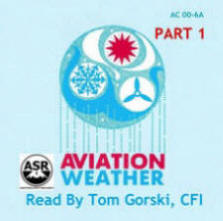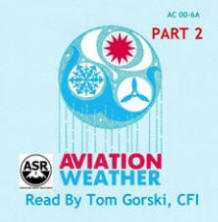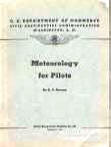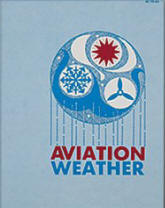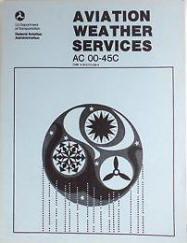|
|
|||

Aviation Safety Research
"Technical Research in the
field of Aeronautics"
|
|||
|
|
|
||
|
|
|||
|
2:47 |
|||
|
ALBUM NOTES and again in
1965 under its present title.
All former editions suffered from one common problem. They dealt in
part with weather services which change continually in keeping with current
techniques and service demands. Therefore, each edition became somewhat
outdated almost as soon as published; and its obsolescence grew throughout
the period it
remained in print.
|
|||
 |
|||
|
AVIATION WEATHER PART I WHAT YOU SHOULD KNOW ABOUT WEATHER |
Select Picture to Listen
(MP3) Listen to Album 3 Hrs, 39 Min, 37 Sec. |
||
|
THE EARTH'S ATMOSPHERE 6:08 Composition Vertical Structure The Standard Atmosphere Density and Hypoxia |
|
||
|
TEMPERATURE 12:58 Temperature Scales Heat and Temperature Temperature Variations In Closing |
|
||
|
ATMOSPHERIC PRESSURE AND ALTIMETRY 27:05 Atmospheric Pressure Altimetry In Closing |
|
||
|
WIND
|
|
||
|
MOISTURE CLOUD FORMATION AND PRECIPITATION 16:54 Water vapor Change of State Cloud Formation Precipitation Land and Water Effects In Closing |
|
||
|
STABLE AND UNSTABLE AIR 15:27 Changes Within Upward and Downward Moving Air Stability and Instability What Does It All Mean? |
|
||
|
CLOUDS 9:39 Identification Signposts in the sky |
|
||
|
AIRMASSES AND FRONTS 23:35 Air Masses Fronts Fronts and Flight Planning |
|
||
|
TURBULENCE 21:39 Convective Currents Obstructions to Wind Flow Windshear Wake Turbulence In Closing |
|
||
|
ICING 17:04 Structural Icing Induction System Icing Instrument Icing Icing and Cloud Types Other Factors in Icing Ground Icing Frost In Closing |
|
||
|
THUNDERSTORMS 25:28 Where and when? They Don't Just Happen The Inside Story Rough and Rougher Hazards Thunderstorms and Radar Do's and Don'ts of Thunderstorm Flying |
|
||
|
COMMON IFR PRODUCERS 19:23 Fog Low Stratus Clouds Haze and Smoke Blowing Restrictions to Visibility Precipitation Obscured or Partially Obscured Sky In Closing |
|
||
|
AVIATION WEATHER
PART II OVER AND BEYOND |
Select Picture to Listen
(MP3) Listen To Album 2 Hrs, 15 Min 17 Sec |
||
|
HIGH ALTITUDE WEATHER 19:44 The Tropopause The Jet Stream Cirrus Clouds Clear Air Turbulence Condensation Trails Haze Layers Canopy Static Icing Thunderstorms |
|
||
|
ARCTIC WEATHER 18:30 Climate Air Masses and Fronts Arctic Peculiarities Weather Hazards Arctic Flying Weather In Closing |
|
||
|
TROPICAL WEATHER 29:34 Circulation Transitory Systems |
|
||
|
SOARING WEATHER |
|||
|
Thermal soaring 39:35 Frontal soaring 1:35 Sea Breeze Soaring 9:18 |
Ridge or Hill Soaring 5:10 Mountain Wave Soaring & In Closing 9:24 |
|
|
|
|
|||
|
Produced by ASR |
|||
